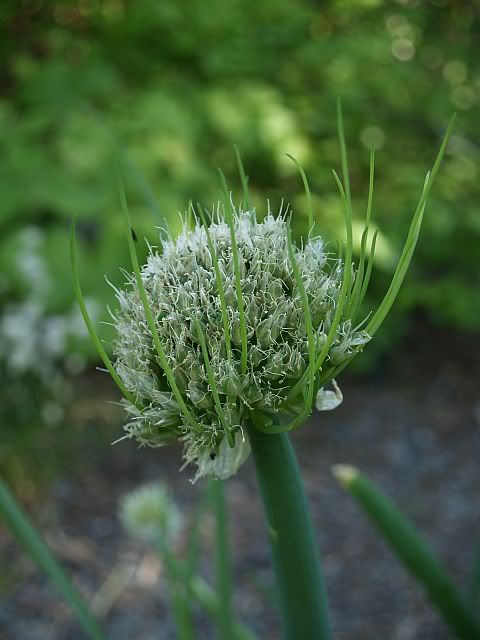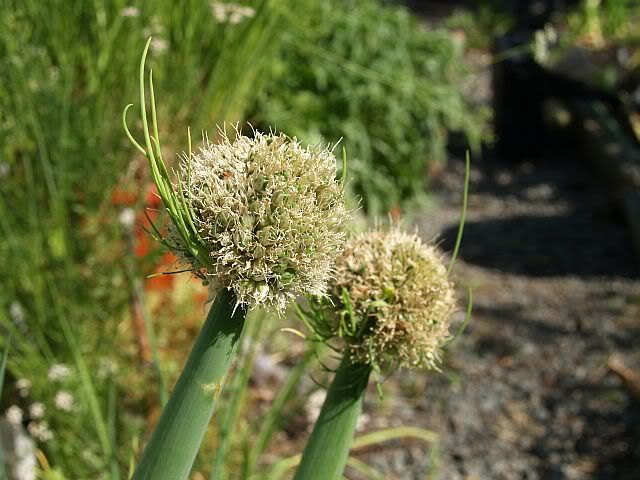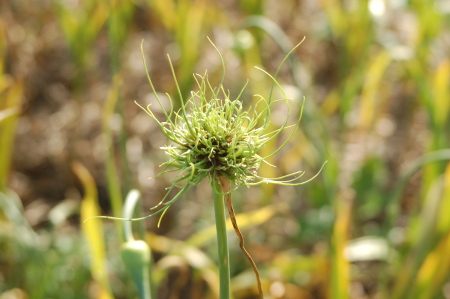|
|
Post by stevil on Jul 11, 2009 4:48:34 GMT -5
Two of my Allium fistulosum cultivars sourced from SSE as seed have developed small bulbils in the flower heads. As I’ve never seen this in my older material here, I wondered if anyone else has seen this/ how common it is/ and if so which varieties? I've read in Allium Crop Science (available on-line to download) that topset forms of both Allium cepa and A. fistulosum exist, but never seen this (of course these bulbils are so small that they aren't much use in the kitchen, but it is another way to multiply the varieties). Stevenson’s multiplier:  Franz Bunching:  |
|
|
|
Post by flowerpower on Jul 12, 2009 5:53:50 GMT -5
I've only seen that on a variety of top-setting garlic. Did any of the plants produce seed, as well as the bulbils?
|
|
|
|
Post by PatrickW on Jul 12, 2009 8:17:40 GMT -5
That sort of looks like topsets I've seen on Creole type garlics. I'll try to get a picture the next time I go to the garden.
|
|
|
|
Post by PatrickW on Jul 14, 2009 6:04:26 GMT -5
Okay, now that I put the pictures next to each other they don't seem as similar after all. It is similar in a vague sense to garlic topsets. Here's what the topset of Creole Red garlic looks like:  |
|
|
|
Post by PatrickW on Jul 14, 2009 6:07:39 GMT -5
By the way, it's know that in garlic seed production can be stimulated by removing the bulbils from the flower stalk. If you're interested in more seeds rather than bulbils, this may work with Allium fistulosum.
|
|
|
|
Post by stevil on Jul 16, 2009 6:12:31 GMT -5
I've only seen that on a variety of top-setting garlic. Did any of the plants produce seed, as well as the bulbils? Too early to tell yet, but it looks like there will also be seed. |
|
|
|
Post by stevil on Jul 16, 2009 6:14:55 GMT -5
Okay, now that I put the pictures next to each other they don't seem as similar after all. It is similar in a vague sense to garlic topsets. Here's what the topset of Creole Red garlic looks like:  Thanks for posting this. Never seen a garlic like that one before! This is an Allium sativum variety, right? Any chance of a few topsets when ready? |
|
|
|
Post by stevil on Jul 16, 2009 6:16:26 GMT -5
By the way, it's know that in garlic seed production can be stimulated by removing the bulbils from the flower stalk. If you're interested in more seeds rather than bulbils, this may work with Allium fistulosum. Have you succeeded in getting seed from Garlic? |
|
|
|
Post by ottawagardener on Jul 16, 2009 9:02:42 GMT -5
I've seen this in a Toga Sperling top onion. A. fistulosum. I would have saved seed and propogated bulblets after reading this but someone knocked over the top heavy stock.  |
|
|
|
Post by PatrickW on Jul 16, 2009 15:16:05 GMT -5
Have you succeeded in getting seed from Garlic? No, it just takes too much work. I have the problem I have to travel to my garden, and every year I get rust on my plants. I've stopped trying. Plants can either be male fertile, female fertile or most often sterile. It takes a lot of work to get the bulbils out without damaging the rest of the topset, then you need to get it on male and female plants at the same time, then you need to cross pollinate them by hand. Since this is all happening as the topset is dying off, you also need to foliar feed the plants to try to slow the drying process. The seed you get has a very low germination rate (just a few percent). It's really a lot of work to do, and takes a lot of trial and error. The rust is really my biggest problem, and I never got very far trying. I can put you in touch with someone who could tell you more about it if you're interested. Last I heard he was on his second year growing out his new variety from seed. There have even been some commercial efforts to do this, but I think everyone has given up hope on the idea. Okay, seeds from shallots, it should be possible from garlic too, right? Don't let anyone tell you it's not possible to breed garlic! I'm expecting to get some garlic varieties this year from someone at the University of Wageningen who went on a garlic gathering expedition to Uzbekistan specifically looking for varieties to use for seed production. |
|